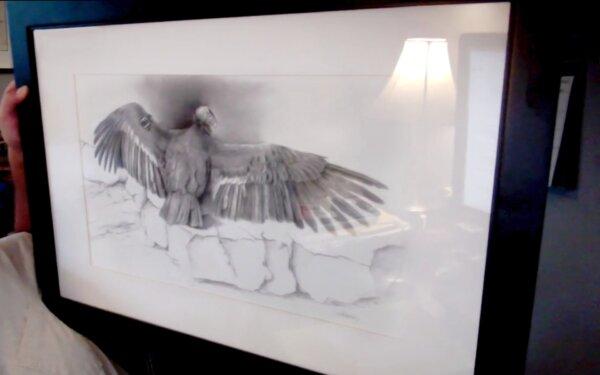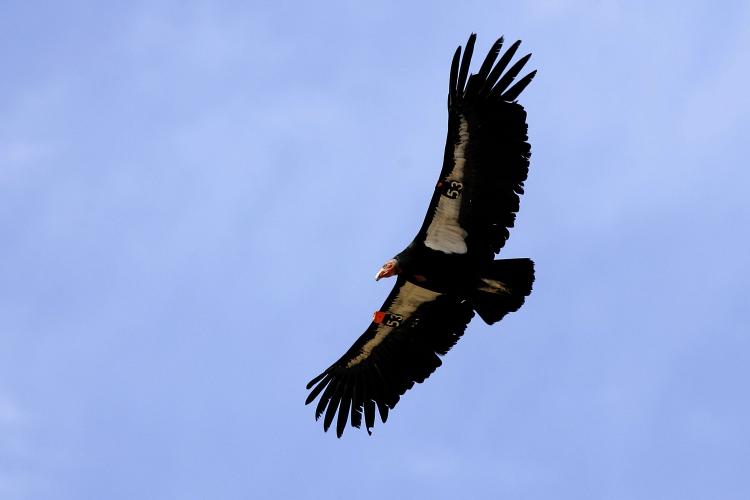With wings spanning nine and a half feet and striking white underwing feathers, the California condor is making a comeback after facing near extinction just four decades ago.
As of last year, 344 condors now fly free in parts of California and nearby states. An additional 217 are in captivity, including breeding pairs, chicks, and viable eggs, according to the U.S. Fish and Wildlife Service (FWS).
The wild population is comprised of five different flocks, intentionally separated by distance to ensure genetic diversity and that a single threat does not harm the entire population.
“We owe it to the birds to not let them go extinct,” Tim Hauck, program director for The Peregrine Fund’s Condor Recovery Program, told The Epoch Times.
Hauck has been involved in condor recovery since 2005 and said he will never forget the first time he held a 20-pound bird and felt the breathing and heartbeat of a species “we nearly lost.” He said the story of condors facing near extinction, their resilience, and humans coming together to preserve and save them motivated him to work with a single species for nearly two decades.
Thousands of years ago, condors thrived across North America, including western Canada and northern Mexico, but the population faced a drastic decline by the mid-20th century, according to the FWS.
In 1967, the federal government listed the California condor as an endangered species. The National Park Service says the sharp population decline was attributed to habitat loss, egg and feather collection, shooting, and lead poisoning.
Because condors, like vultures, are scavengers, they ingest fragments of lead bullets in gut piles left by hunters and eventually die from lead toxicosis, Ashleigh Blackford, coordinator for the California Condor Recovery Program at FWS, told The Epoch Times.
Since the threat of lead couldn’t be immediately removed from the landscape at the time, wildlife agencies and conservationists developed what was seen as “a contentious decision at the time” to place transmitters on the birds, Blackford said.
FWS launched the California Condor Recovery Program in 1979 to determine the causes of death and to monitor population size, active nests, food sources, and feeding areas.
However, by 1982, only 22 California condors remained in the wild.
In the following five years, federal agencies worked with the Los Angeles and San Diego zoos to develop a captive breeding program and capture all remaining condors in an effort to save the species.
Raise and Release
The Peregrine Fund partnered with FWS in 1993 to breed and release condors at its World Center for Birds of Prey in Boise, Idaho. The organization also works closely with three zoos in Los Angeles, San Diego, and Oregon to breed California condors in captivity.
Because condor pairs only produce one egg every one to two years, the captive breeding program has stepped in to help double that number.
The first egg produced by each breeding pair is removed and incubated. The breeding pair will then produce a second egg, which they may be allowed to keep.

An animal keeper at Los Angeles Zoo checks California condor eggs during the 2024 breeding season. (Courtesy of Los Angeles Zoo)
After the eggs hatch, adult birds will raise the chicks for about a year, teaching them “how to use the air current, learning the landscape, learning how to find food,” said Blackford.
According to The Peregrine Fund, condors are “highly intelligent and curious” and can learn to associate food with humans if they become too familiar with people. To prevent this from happening, young condors are raised in environments where they rarely see or hear people.
For example, at the World Center for Birds of Prey breeding site, herds of goats are used to clear nearby brush instead of lawnmowers, the birds are monitored using cameras, food is delivered through a chute, and caretakers work as quietly as they can.
Once young condors are ready to fly free, local organizations work with their federal partners to release the birds at one of six sites: Vermilion Cliffs, Hopper Mountain Wildlife Refuge Complex, Pinnacles National Park, Redwood National Park, Big Sur, and Baja California.
Where the birds are released is based on their genetics, and biologists determine which flock suits each bird to maintain genetic diversity.

A condor undergoes a procedure. (Courtesy of Oakland Zoo)
In the wild, biologists continue monitoring the birds, their environment, and any new nests or chicks. Condors start breeding once they reach six or seven years old.
“Nesting is one of those great successes that we’re always looking for,” said Hauck.
He recalled the time he was still a new, young biologist and had to hike three days in a remote section of the Grand Canyon to confirm a nest that was particularly difficult to find and reach.
Equipped with water jugs to stay hydrated and telemetry equipment to monitor the birds, Hauck searched everywhere for the nesting pair. Temperatures reached 100 degrees during the day, so he would venture out in the evenings and early mornings when the heat was more bearable.
“I was on one side of this big canyon. There’s this plateau, and the nest happened to be on the complete opposite side,” Hauck said. “I didn’t know at the time, but the female came in.”
Wild condor pairs fly into their nests every few days to feed their chicks.
“She had this massive crop [food storage pouch]. She flies over my head and she’s definitely heading towards the nest,” he recalled.
To not miss the opportunity, he said he ran roughly a mile across the plateau and canyon, climbed over a wall, and looked down. At the entrance of a cave stood the mother condor feeding her three-month-old chick.
“I was the first person to ever set eyes on this really young condor, which ended up getting the number 441,” Hauck said. “It was really special to me.”
California condors may live over 60 years. Today, #441 is still thriving in the Vermilion Cliffs and raising the next generation of wild condors. Hauck’s team recently confirmed its third offspring.
He says he hopes to see #441’s chicks growing up and producing their own offspring, so that “we can have our first F3 generation condors out there.”

Tim Hauck shows a drawing of condor #441 during an online interview. (Screenshot/The Epoch Times)
Lead Threats
While the California condor population is steadily increasing, data show that birds still face the same threat that nearly drove them to extinction—lead poisoning from bullets.
From 1992 to 2023, lead poisoning was responsible for 48 percent of the 285 recorded condor deaths with a known cause, according to data from the FWS.
As a hunter himself, Hauck said, “It’s as simple as just changing our ammunition type to something that’s lead-free,” which would greatly reduce the amount of lead getting into the environment.
Bullets made with lead can fragment inside the animal being hunted, since lead is a soft metal.
A single contaminated animal carcass can impact multiple condors, including their chicks if the parents bring the food back to the nest. Ingested lead weakens the birds and damages their central nervous system, eventually leading to death if untreated.

A California condor in the wild. (Courtesy of National Park Service)
Over the years, states have implemented different management strategies to address the lead threat.
In 2013, California Gov. Jerry Brown signed a law banning lead ammunition for hunting wildlife anywhere in the state. The law took effect in 2019.
Arizona and Utah have adopted an outreach approach. Representatives from these states’ agencies go out and make contact with hunters, provide education on lead bullets, and offer a free box of non-lead ammunition.
“Ultimately, the hunters and shooters on the landscape are the ones that can solve this problem,” Hauck said.
Even with laws and outreach programs, lead continues to harm condors in California, Arizona, and Utah.
This year, California condor 1K was found dead due to lead poisoning. In an Aug. 5 announcement, The Peregrine Fund said 1Kwas the 1,000th condor hatched since the beginning of the California Condor Recovery Program.
Another solution, Blackford said, is “simply to collect the animal that is killed and to collect the gut pile.” She says this move would remove the threat of lead from the landscape without asking hunters to buy different bullets.
Bird Flu and Vaccines
In March 2023, a new threat emerged when the Highly Pathogenic Avian Influenza (HPAI) began to claim the lives of condors in the Arizona–Utah flock.
Biologists were picking up one to two dead condors every day for roughly three weeks. To date, 21 condors in that flock have died.
“That’s a new threat that was not on the landscape previously,” Blackford said.
In response to the outbreak, the FWS was granted emergency use authorization to vaccinate every condor against HPAI.
“This is the first instance where the U.S. Department of Agriculture has allowed for any use of HPAI vaccine in the United States,” said Blackford. “It’s completely novel.”
At the same time, field biologists continued monitoring birds in the wild for signs of illness. They also tightened biosecurity measures, which included swabbing birds and not putting out food for wild condors.
The last reported case of HPAI in a condor was on April 11, 2023, with no new cases since.
The Arizona–Utah flock was the only flock exposed to the virus, and all birds are now vaccinated before being released into the wild.
“It’s kind of like poking around in the dark,” Hauck said. “We don’t know how effective it is yet, because we haven’t seen another outbreak.”
According to FWS, continued blood tests have detected antibodies to HPAI, indicating that the condors that were exposed and survived are building natural immunity to the virus.
As a result of the virus outbreak paired with continued lead poisoning, the Arizona–Utah flock dropped from a population high of 116 condors to 80.

California condor #374 flies overhead. (Courtesy USFWS)
Symbol of Renewal
Hauck said the next challenge is rebuilding the flock and eventually a self-sustaining wild condor population.
On Sept. 28, four young captive-bred condors will be released at Vermilion Cliffs National Monument, joining the Arizona-Utah flock.
One notable condor set to soar this month is #1221, which lost its mother to the HPAI outbreak and was brought into captivity to ensure its survival.
The event is part of The Peregrine Fund’s 28th annual public condor release, which will be in person and live-streamed.
Another organization releasing condors this month is the Yurok Tribe in Northern California. The birds from their release site join the flock living in Redwood National Park.
For the Yurok Tribe, the reintroduction of these condors is not just about saving a species; it is also saving a piece of the tribe’s history and culture.
“California condors, or prey-go-neesh in Yurok, have been spiritually tied to the Yurok,” the tribe’s website reads.
For the Yurok, condor feathers and songs have been “foundational components” of Yurok World Renewal ceremonies, which aim to restore balance to the world and environment.
By being part of the restoration program, their goal is to “return the condor to the integral role it plays in healthy ecosystems and, in doing so, to renew and strengthen the spiritual lifeways of the many tribes who revere this majestic species.”













